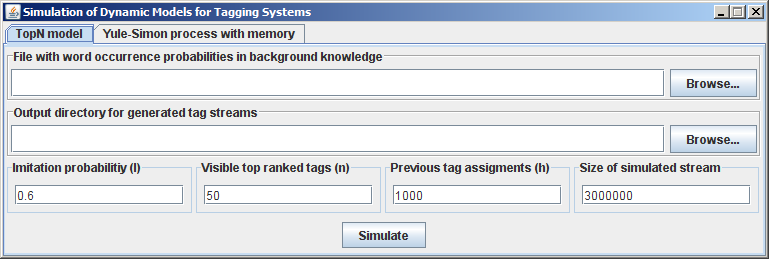
Epistemic dynamical tagging model
 This generative tagging simulator has been developed by the Institute for Computer Science at the University of Koblenz-Landau. It integrates both the background knowledge and the influence of previous tag assignments. It successfully reproduces characteristic properties of tag streams and even explains effects of the user interface on the tag stream. The simulator reproduces two widely accepted algorithm for producing artificial tag stream, statistically similar to the real datasets found in collaborative tagging communities. It is written in Java and is available online via the institute’s website, where additional documentation can be found. Along with the software, an archive containing all generated tag streams, the software simulator and the technical report is provided. A README file describes how to start the software simulator and which files are contained in the archive with the artificial tag streams. Click on the image to view a screenshot of the simulator.
This generative tagging simulator has been developed by the Institute for Computer Science at the University of Koblenz-Landau. It integrates both the background knowledge and the influence of previous tag assignments. It successfully reproduces characteristic properties of tag streams and even explains effects of the user interface on the tag stream. The simulator reproduces two widely accepted algorithm for producing artificial tag stream, statistically similar to the real datasets found in collaborative tagging communities. It is written in Java and is available online via the institute’s website, where additional documentation can be found. Along with the software, an archive containing all generated tag streams, the software simulator and the technical report is provided. A README file describes how to start the software simulator and which files are contained in the archive with the artificial tag streams. Click on the image to view a screenshot of the simulator.
NET
 NET is a software developed by Vito D.P. Servedio of the Physics Department at University “Sapienza” of Rome, Italy. It is thought to help researchers in the field of complex networks to analyse the statistical properties of complex networks. NET provides tools to both analyze and generate random graphs: it can run multiple realizations of network generation models and perform multiple realization (ensemble) statistics; alternatively, it can perform single and multiple statistics on networks read from files.
NET is a software developed by Vito D.P. Servedio of the Physics Department at University “Sapienza” of Rome, Italy. It is thought to help researchers in the field of complex networks to analyse the statistical properties of complex networks. NET provides tools to both analyze and generate random graphs: it can run multiple realizations of network generation models and perform multiple realization (ensemble) statistics; alternatively, it can perform single and multiple statistics on networks read from files.
It is written in C. NET generates networks according to the “rich-get-richer” model introduced by Barabasi and Albert, or to the fitness model introduced by Caldarelli et al. As an analysis tool for directed, undirected and weighted networks, it performs several tasks including graph reduction according to the minimum betweennes criterium, spectral analysis (requires GSL and Lapack libraries), calculation of the degree distribution and correlations, clustering coefficient, site and edge betweenness, node pair distance and cluster dimension. A graphical frontend is available, requiring the installation of the QT 3.0 libraries. A direct interface with the common XmGrace mathematical plotting software is provided. Networks generated by NET are displayed by the graphical visualization software Graphviz and Grip.
The software package and a user’s manual are available on the developer’s webpage. Click to view a snapshot of its graphical frontend.
TAGora project started on June 1st 2006
Sixth Framework Programme, Information Society Technologies, IST call 5, Contract N. 34721
Powered by WordPress |
Entries and comments feeds |
Valid XHTML and CSS